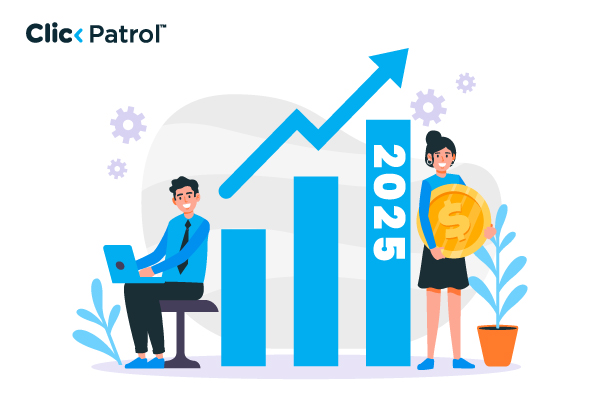Yes, both invalid and fraudulent clicks distort ROI and campaign metrics.
Invalid clicks vs. fraudulent clicks: Protecting your digital ad campaigns
Abisola Tanzako | Nov 14, 2025

Table of Contents
- What are invalid clicks?
- What are fraudulent clicks?
- Impacts of invalid and fraudulent clicks
- Causes of invalid and fraudulent clicks
- How to prevent invalid and fraudulent clicks
- AI and machine learning in ad fraud prevention
- The future of ad fraud
- Securing your campaigns against invalid and fraudulent clicks
Clicks and impressions are critical metrics in digital advertising. However, not all interactions are genuine. Understanding the distinction between invalid clicks and fraudulent clicks is key to protecting your ad budget, optimizing campaigns, and ensuring reliable analytics.
According to Statista, global ad fraud losses reached $84 billion in 2023 and are projected to surpass $100 billion by 2025. Forbes reports that up to 40% of digital ad spend in specific sectors is impacted by click fraud or invalid traffic. With stakes this high, advertisers need to differentiate between harmless mistakes and intentional deception.
This guide explains the differences, causes, impacts, and strategies to reduce invalid and fraudulent clicks.
What are invalid clicks?
Invalid clicks are user interactions that do not reflect a genuine interest in your ad. Common causes include:
- Accidental clicks: Users click by mistake due to poor ad placement or mobile interface issues.
- Bots or automated scripts: Programs that mimic human behaviour to inflate click counts.
- Click farms: Teams of humans or automated systems that click ads to artificially boost metrics.
- Competitor interference: Competitors intentionally click your ads to deplete your budget.
Invalid impressions occur when an ad is technically displayed but never actually seen by a real human:
- Ad stacking: Multiple ads layered on top of each other, counted as impressions, though only the top ad is visible.
- Pixel stuffing: Ads are displayed in tiny or invisible iframes.
- Non-human traffic: Bots generating page loads that count as impressions.
- Geographic mismatch: Impressions served to audiences outside your target location.
Example: Google Ads automatically identifies invalid clicks caused by repeated bot activity or accidental user interactions to protect advertisers’ budgets.
What are fraudulent clicks?
Fraudulent clicks are a deliberate form of ad fraud. Unlike accidental or bot-driven invalid clicks, these are intentionally generated to cause financial loss or manipulate campaign metrics. Common types include:
- Click fraud by competitors: Direct attempts to drain your ad budget.
- Automated fraud networks: Sophisticated systems generating high-volume fake clicks.
- Incentivized fraudulent clicks: Paid participants or bots directed to click ads repeatedly.
Fraudulent clicks are always intentional, whereas some invalid clicks may occur by accident or due to a system error.
Impacts of invalid and fraudulent clicks
The impacts include:
Financial losses
Invalid and fraudulent clicks can waste 20–40% of digital ad budgets. Example: A $100,000 PPC campaign could lose $20,000 to $40,000 due to non-genuine clicks.
Distorted analytics
Misleads CTR, conversion rates, and ROI analysis. Invalid data hinders optimization strategies.
Eroded trust
Continuous exposure to fraud decreases confidence in platforms like Google Ads and Meta Ads.
Competitive disadvantage
Competitors exploiting click fraud can quickly overshadow small businesses’ campaigns.
Causes of invalid and fraudulent clicks
They include:
- Accidental user clicks: Mistakes from mobile interface issues or mis-clicks.
- Bots and automated scripts: Automated traffic inflating impressions and clicks.
- Click farms: Paid teams creating fake engagement.
- Poor ad placement: Ads placed below the fold or near navigation buttons can lead to accidental clicks.
- Competitor sabotage: Intentional repeated clicks to drain the budget.
How to prevent invalid and fraudulent clicks
Here are ways to prevent invalid and fraudulent clicks:
- Utilize fraud detection tools: Platforms such as ClickPatrol, DoubleVerify, and Google Ads can help detect and block invalid traffic.
- Monitor campaign metrics closely: Watch for CTR spikes with low conversions, repeated clicks from the same IP address, or unusual traffic patterns.
- Optimize ad placement: Avoid placements prone to accidental clicks; ensure visibility to the right audience.
- Geo-targeting and audience segmentation: Limit ad delivery to relevant locations and demographics.
- Collaborate with trusted ad networks: Reputable networks detect and filter invalid and fraudulent traffic.
- Educate your team: Train marketing staff to identify red flags and respond promptly.
AI and machine learning in ad fraud prevention
Artificial intelligence (AI) and machine learning (ML) are transforming the way advertisers detect and prevent invalid and fraudulent clicks.
These technologies can analyze vast volumes of traffic data in real time, identify unusual patterns, and flag suspicious interactions before they result in wasted ad spend.
For instance, AI systems can detect anomalies such as unusually high click volumes from a single IP address. These repetitive patterns indicate bots, or sudden spikes in traffic that do not correlate with conversions.
By recognizing these patterns early, marketers can prevent financial losses, optimize campaigns, and maintain the integrity of analytics.
Statista reports that AI can reduce invalid impressions by up to 35%. At the same time, Forbes predicts that by 2025, 70% of ad platforms will rely on AI-powered systems to filter out invalid and fraudulent traffic.
This trend demonstrates that AI is no longer just an optional tool; it is becoming a standard safeguard in digital advertising.
The future of ad fraud
As the digital advertising ecosystem grows, ad fraud is becoming increasingly sophisticated, using advanced bots, click farms, and automated fraud networks.
To stay ahead, advertisers need to adopt emerging technologies that offer greater transparency and proactive protection.
Blockchain ad tracking:
Blockchain technology provides an immutable record of ad delivery and interactions, allowing advertisers to verify that clicks and impressions are authentic.
This transparency helps prevent fake clicks and ensures every engagement is traceable.
Advanced verification tools:
Modern AI-powered verification tools continuously adapt to new fraud techniques. They can detect automated traffic, monitor unusual click behavior, and prevent suspicious clicks from draining ad budgets.
By integrating these solutions, businesses can reduce their exposure to both invalid and fraudulent clicks, making their campaigns more reliable and efficient.
Securing your campaigns against invalid and fraudulent clicks
Invalid clicks can be accidental or driven by bots, while fraudulent clicks are intentional attempts to manipulate campaigns.
Both impact budgets, analytics, and trust.
By using AI tools, monitoring campaigns, optimizing ad placement, and collaborating with credible networks, advertisers can safeguard their campaigns and maximize ROI.
Protect your campaigns from invalid and fraudulent clicks today. Utilize AI-powered tools, monitor traffic, and optimize placement to ensure your ad spend yields tangible results.
Frequently Asked Questions
-
Can invalid traffic affect ROI?
-
How often should campaigns be audited?
Regular audits are recommended weekly or monthly, depending on traffic volume.
-
Are bot-generated impressions common?
Yes, Statista reports 42% of digital ad impressions in 2023 were bot-driven.
-
Do geo-targeted campaigns reduce invalid traffic?
Yes, targeted campaigns generate about 25% less invalid traffic than broad campaigns.
-
Can AI prevent fraudulent clicks?
AI can detect suspicious behavior patterns and block fraudulent clicks before they impact your budget.






